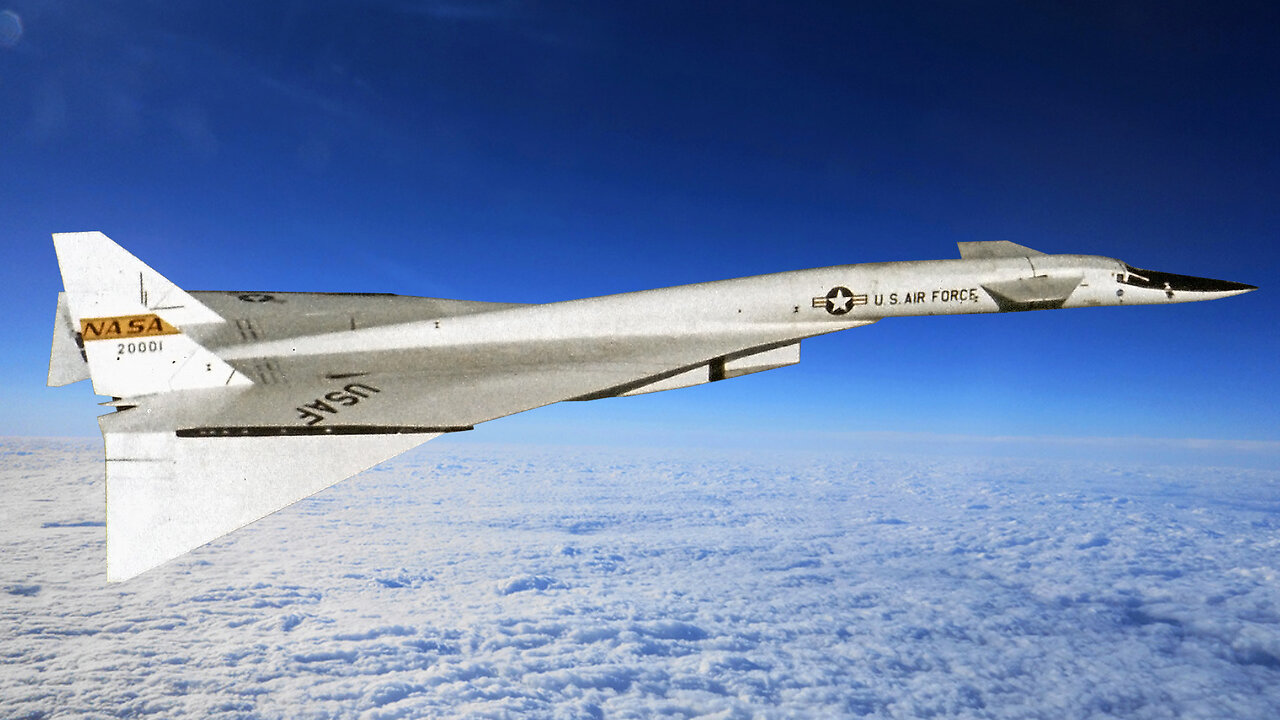Premium Only Content

The World’s Fastest Nuclear Bomber: North American XB-70 Valkyrie | Mach 3 Aircraft
The World’s Fastest Nuclear Bomber: North American XB-70 Valkyrie | Mach 3 Aircraft
The North American Aviation XB-70 Valkyrie was the prototype version of the planned B-70 nuclear-armed, deep-penetration supersonic strategic bomber for the United States Air Force Strategic Air Command. Designed in the late 1950s by North American Aviation (NAA), the six-engined Valkyrie was capable of cruising for thousands of miles at Mach 3+ while flying at 70,000 feet (21,000 m).
By the mid-1950s, the United States had developed a state-of-the-art, all-jet-powered bomber force. The newly introduced Boeing B-52 Stratofortesss could reach the Soviet Union from just about anywhere in the world. The soon-to-be-introduced supersonic Convair B-58 Hustler could dash to supersonic speeds. Both aircraft were engineering marvels. But even so, they were expected to perform poorly over Soviet airspace. The B-52 flew too slowly to stand a chance against the latest generation of Soviet interceptors, while the supersonic B-58 lacked the required range and payload to be truly effective. The U.S. Air Force needed a next-generation bomber that would combine the capabilities of both these aircraft. A plane that could fly at supersonic speeds, travel long distances, and carry large payloads.
To meet their new bomber requirements, the Air Force contracted leading aerospace companies to explore radical new technologies, like nuclear-powered jet engines for extending aircraft range and high-energy ‘zip-fuels’ to increase aircraft performance. Boeing and North American Aviation would play a vital role in research. But given the limitations of technology, the most practical solution put forward was the ‘dash concept’ which detailed an enormous aircraft that would travel subsonically most of the way to its target, before jettisoning outer portions of its wings and fuel tanks to make a supersonic dash. These concepts were studied in an era of extraordinary advances in aviation technology and engineering, and by 1957 it became apparent that it might be possible to build a large, long-range bomber that could fly supersonically over its entire mission.
In 1957, the Air Force outlined their specifications for an aircraft that would cruise at Mach 3, up to an altitude of 75,000 feet. It was expected to offer a similar payload and range to the B-52. Boeing and North American Aviation both submitted design concepts, but North American’s proposal was selected for development. A key principle in North America’s design was compression lift, which would significantly improve the aircraft’s lift-to-drag ratio when flying at high supersonic speeds. The new bomber would be designed as the B-70 (XB-70 in experimental prototype form) and named the Valkyrie.
General characteristics
Crew: 2
Length: 185 ft 0 in (56.39 m)
Wingspan: 105 ft 0 in (32.00 m)
Height: 30 ft 0 in (9.14 m)
Wing area: 6,297 sq ft (585.0 m2)
Airfoil: Hexagonal; 0.30 Hex modified root, 0.70 Hex modified tip
Empty weight: 253,600 lb (115,031 kg)
Gross weight: 534,700 lb (242,536 kg)
Max takeoff weight: 542,000 lb (245,847 kg)
Fuel capacity: 300,000 pounds (140,000 kg) / 46,745 US gal (38,923 imp gal; 176,950 L)
Powerplant: 6 × General Electric YJ93 afterburning turbojet, 19,900 lbf (89 kN) thrust each dry, 28,000 lbf (120 kN) with afterburner
Performance
Maximum speed: 1,787 kn (2,056 mph, 3,310 km/h)
Maximum speed: Mach 3.1
Cruise speed: 1,738 kn (2,000 mph, 3,219 km/h)
Combat range: 3,725 nmi (4,287 mi, 6,899 km)
Service ceiling: 77,350 ft (23,580 m)
Lift-to-drag: about 6 at Mach 2
Wing loading: 84.93 lb/sq ft (414.7 kg/m2)
Thrust/weight: 0.314
-
 21:38
21:38
Joseph Wouk's Channel
2 months agoThis Is WAY Bigger Than I Thought… Victor Davis Hanson
1241 -
 LIVE
LIVE
Trumpet Daily
49 minutes agoTrumpet Daily LIVE - July 25, 2025
1,623 watching -
 27:21
27:21
Uncommon Sense In Current Times
17 hours agoThis Is NOT Civil Disobedience | LA Protests | Peter Demos
7.61K1 -
 22:40
22:40
Devin Nunes
2 hours agoHouse Intelligence Committee's ICA report blows up Russia Hoax once and for all
54.6K31 -
 1:00:55
1:00:55
Dr. Eric Berg
4 days agoThe Dr. Berg Show LIVE July 25, 2025
6K2 -
 LIVE
LIVE
LFA TV
14 hours agoLFA TV ALL DAY STREAM - FRIDAY 7/25/25
3,774 watching -
 1:02:20
1:02:20
VINCE
4 hours agoGhislaine Has Talked! What Did She Say? | Episode 93 - 07/25/25
179K110 -
 1:10:17
1:10:17
The Big Mig™
4 hours agoBiden’s Chief Of Staff Snitching On Biden To Congress
23.4K9 -
 DVR
DVR
Bannons War Room
5 months agoWarRoom Live
29.8M7.36K -
 1:14:59
1:14:59
Dear America
4 hours agoClinton Wrote a SHOCKING Birthday Letter To Epstein!! JAIL!! + Rest In Peace Hulk Hogan…
139K94